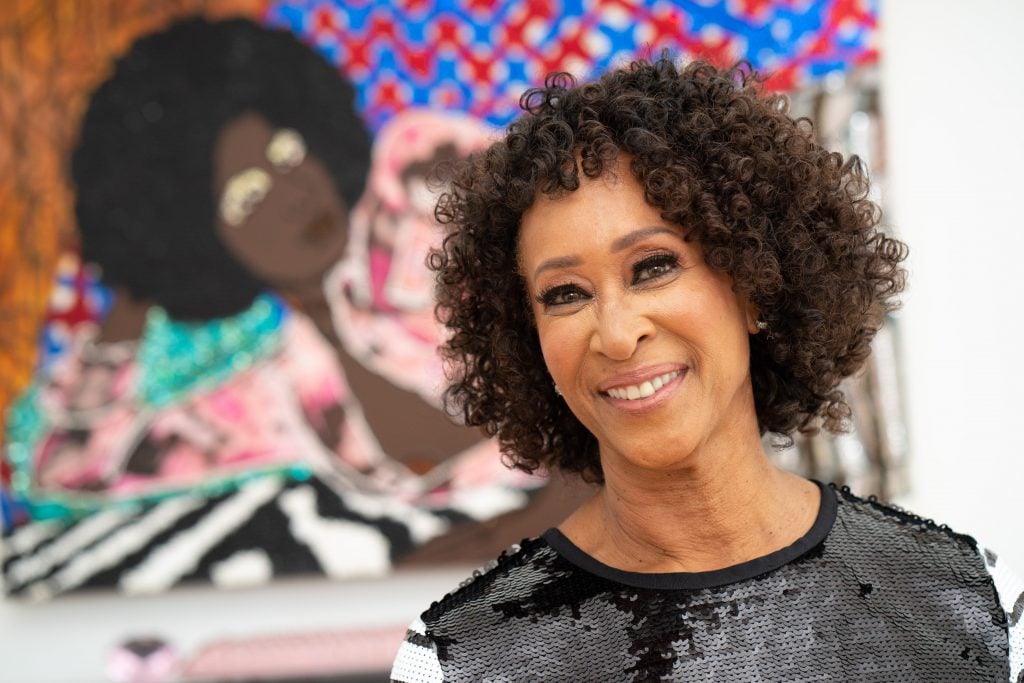Joy Simmons began collecting art as a medical student. Back then, she paid $50 for a work by Elizabeth Catlett in five installments. In the years since, the Los Angeles-based radiologist has built one of the country’s preeminent collections of work by Black artists. Her LA home is filled with life and color through art by David Hammons, Alison Saar, Calida Rawles, Lauren Halsey, and many more.
A board member of the Santa Monica Museum of Art (now the Institute of Contemporary Art, Los Angeles) from 2002 to 2008 and the niece of a founding member of the Studio Museum of Harlem, Simmons says art has helped make her home a haven and provided an endless outlet for discovery. She spoke to Artnet News about seeking out young artists, how she relates art and style, and the collecting misstep she still lords over her ex husband.
What was your first purchase (and how much did you pay for it)?
A print by Elizabeth Catlett, Which Way? (1973). I bought it in 1974, when I was a first-year medical student. It was $50 and it took me five months to pay it off. I had just moved back to Los Angeles from Stanford. I had been looking at Catlett’s work for a long time, and here I was at the crossroads of my career as a physician. I walked into the space and the piece was just there. And I knew—it was my piece. It still hangs in my home, and has never come down.
What was your most recent purchase?
A work by a young artist named Khari Turner, who’s in graduate school at Columbia, Angel of Thugz Mansion. There’s an abstractness about his work, but he focuses on noses, lips, and hands. I was watching him on Instagram for a while and then he came to visit a gallerist here in Los Angeles. It saw the piece and that was it for me. Then he came out here to do a residency at the Iris Project, so I had a chance to meet him and talk to him, which was great.
The piece is perfect, and it’s big. It’s like 53 inches x 48 inches, so getting it framed was a whole thing, but it’s really impressive and when you walk in, you go, “Wow!”
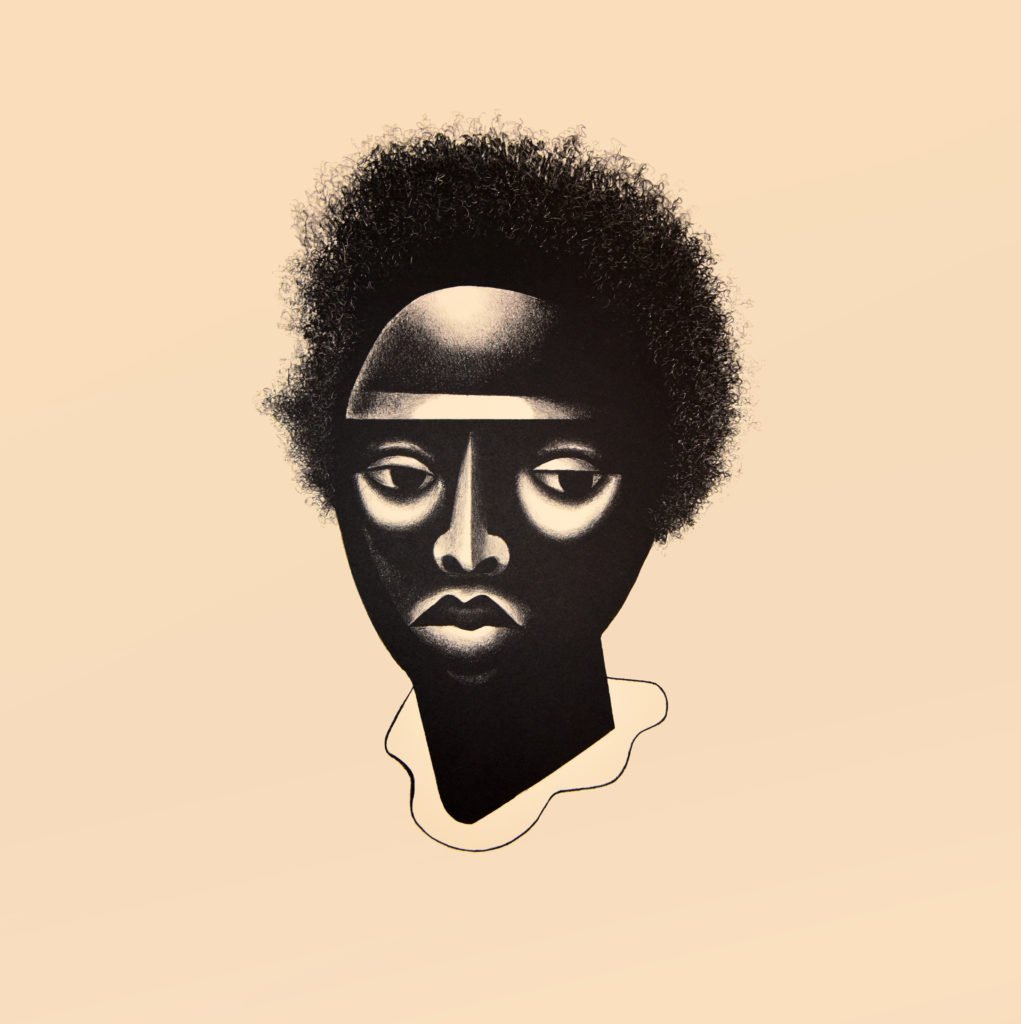
Elizabeth Catlett, Black Girl (2002). Courtesy of Burning in Water.
Which works or artists are you hoping to add to your collection this year?
I’m not really a planner. I like the serendipity in discovering new artists and finding something that just fits. So I try to see a lot. I’m going to Atlanta this weekend for a memorial, for example, but the day before, I’m hitting the art spaces. I just love the discovery part and finding new people. I’m not really focused on how it all adds up. There are a couple of LA artists I’m circling back to and trying to look at their practices now that they’re coming into their own. My eyes are peeled, but we’re also getting close to the end of the year, and I’ve got grandchildren and Christmas presents to get.
What is the most expensive work of art that you own?
There are some that have really appreciated in value, and I couldn’t afford them now, that’s for sure. But the one that I paid the most money for personally was probably a beaded piece by Kori Newkirk. I had been looking at his work for quite a long time, and he’s also a good friend. I just saw this piece and I had to have it.
It’s funny, there’s another collector of his here in Los Angeles whose home we went to and he had another piece of Kori’s and he said, “You know, there was this other work that looked like a waterfall, but I just didn’t like it.” And he just went on and on, and finally I was like, “You know what? That’s the piece that I bought.” It was funny. It just has to hit you the right way, I guess, and this piece really did it for me.
I also have a piece by Kenzi Shiokava, who’s a Japanese-Brazilian artist. Those pieces live together, so they comprise a sort of woodsy corner, if you will. I love it there.
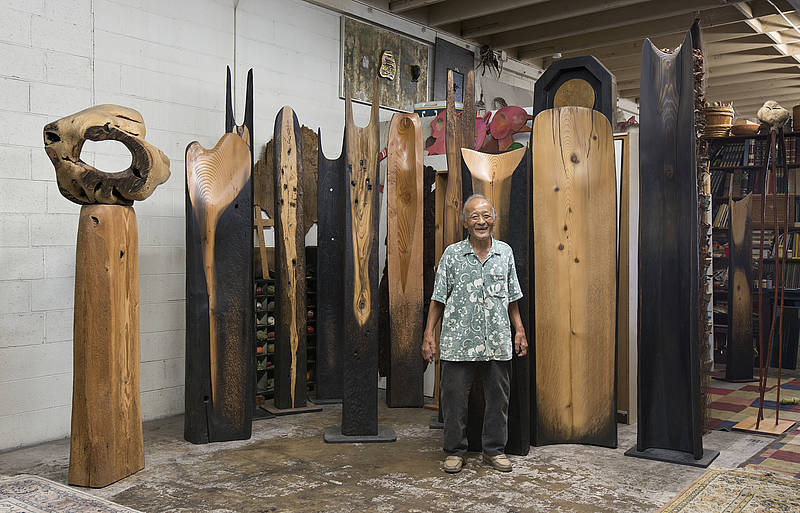
Kenzi Shiokava. Courtesy of Brian Forrest.
Where do you buy art most frequently?
I buy from galleries, but I also buy from the artists directly. Supporting small galleries is very important to me—the ones that find these artists and nurture them before they’re swooped up by the big guys. Some of the galleries I support are Band of Vices, Residency Projects in Inglewood, and Charlie James Gallery in Chinatown. Steve Turner Gallery has a great eye, and he’s been doing this for a long time, but the smaller ones that I mentioned are the ones I support most often. And because I’ve been collecting for such a long time, artists [without representation] come to me and say, “You know, this is what I’m doing. Can you come for a studio visit?”
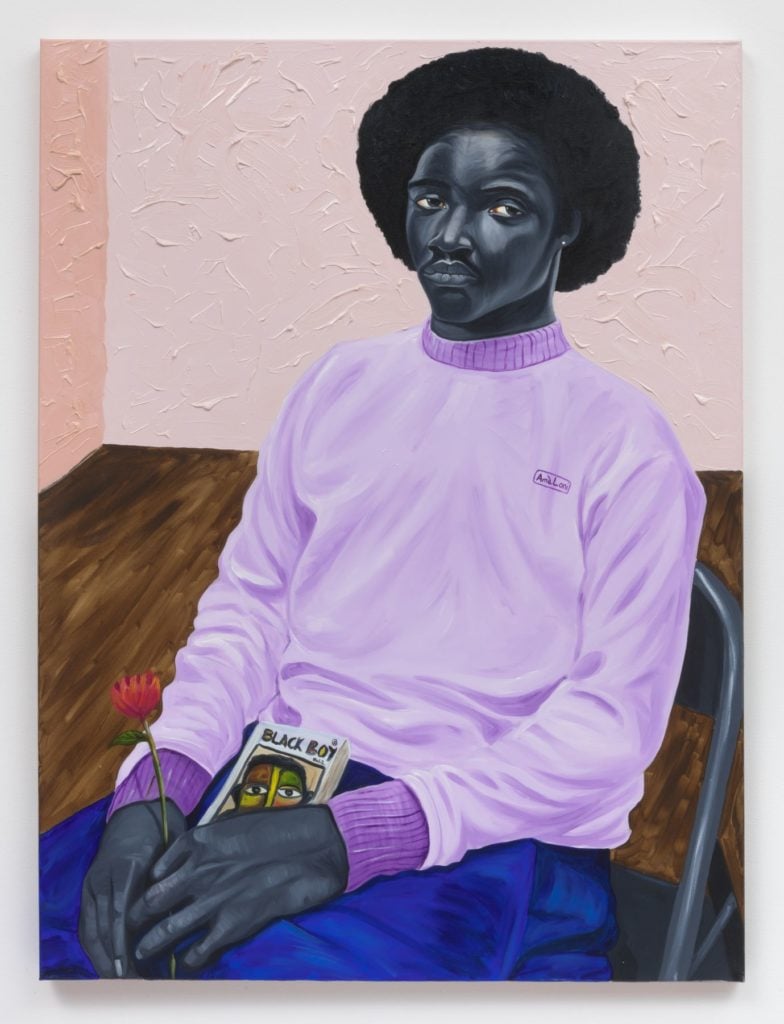
Otis Kwame Kye Quaicoe, Empty Room (2019). Courtesy of Roberts Projects.
Is there a work you regret purchasing?
Not that I regret, per se. There’s one artist—I can’t tell you who it is, because that would just be dead wrong!—that I collected very early and it is a beautiful piece, but the image is a little creepy. So I’ve never hung it in my home really, but when they did a retrospective of his work, I shipped it to be shown at the museum. It’s a beautiful piece, but I just… I couldn’t hang it.
How do you like to display your artwork?
Again, a little serendipity… I buy and then I figure it out later, unless it’s a big piece that would take up what I call “real estate.” I’m a medium-to-heavy kind of hanger. There’s no space left untouched. My daughter is a curator and she always harrumphs when she comes over.
I just got this piece by Otis Quaicoe. It’s called Selfie, and it’s beautiful, a real gem. It’s right downstairs, dangerously close to another piece, but that’s okay. I like to enjoy what I buy. I like to put it all up. So every time I get something, we have to do another re-hang and figure it out. So far, it’s all worked!
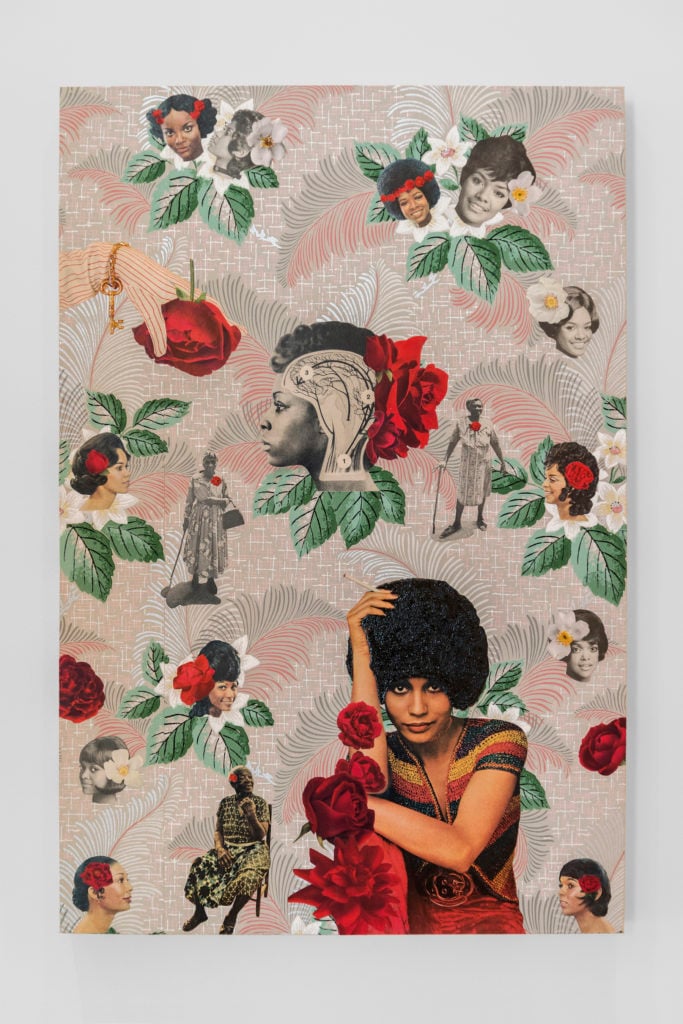
Genevieve Gaignard, She’s So Articulate (2018). Photo courtesy of Shulamit Nazarian, Los Angeles/the FLAG Art Foundation, New York; ©Genevieve Gaignard.
What work do you have hanging above your sofa?
The one over my sofa is by an artist named Wangari Mathenge, part of her “Ascension” series. I keep worrying about people leaning up against it; it drives me nuts. Next to it is a drawing by an artist named Mequitta Ahuja. All her work is autobiographical, and this one is huge. It’s probably about 100 inches long. It looks like hair wrapped in a yellow scarf, and it’s called Bundled. If you’re in New York and you’re looking down from your window at someone walking on the street all bundled up, that’s what this would look like.
What about in your bathroom?
Genevieve Gaignard did an installation in one of the bathrooms. The wallpaper is vintage, and there’s images from Jet magazine, Ebony magazine, images of Black women, and so on. She wallpapered that whole bathroom.
What is the most impractical work of art you own?
I have very tall sculptures, but I don’t get too impractical because I have grandchildren. And even when my kids were little, I never got anything that would be on the ground that they could run into or destroy. But my grandchildren know that you don’t go into the living room. That’s just not a fun place to be. Don’t touch, and don’t go in there [laughs].
What work do you wish you had bought when you had the chance?
Oh, there’s no doubt about this one. When David Hammons was living in Los Angeles, I had an opportunity to buy a sculpture, and it was recently on tour at one of the big shows… either “Soul Of A Nation” or “Now Dig This!” But anyway, my husband would not let me buy that piece. And now that we’re no longer married, every time I see him at a space and we see that work, I look at him and he looks at me and he knows I’m still pissed. So now I buy what I want to buy, period. I was very fortunate to get a “Body” print, but I really would have loved to have had that sculpture.
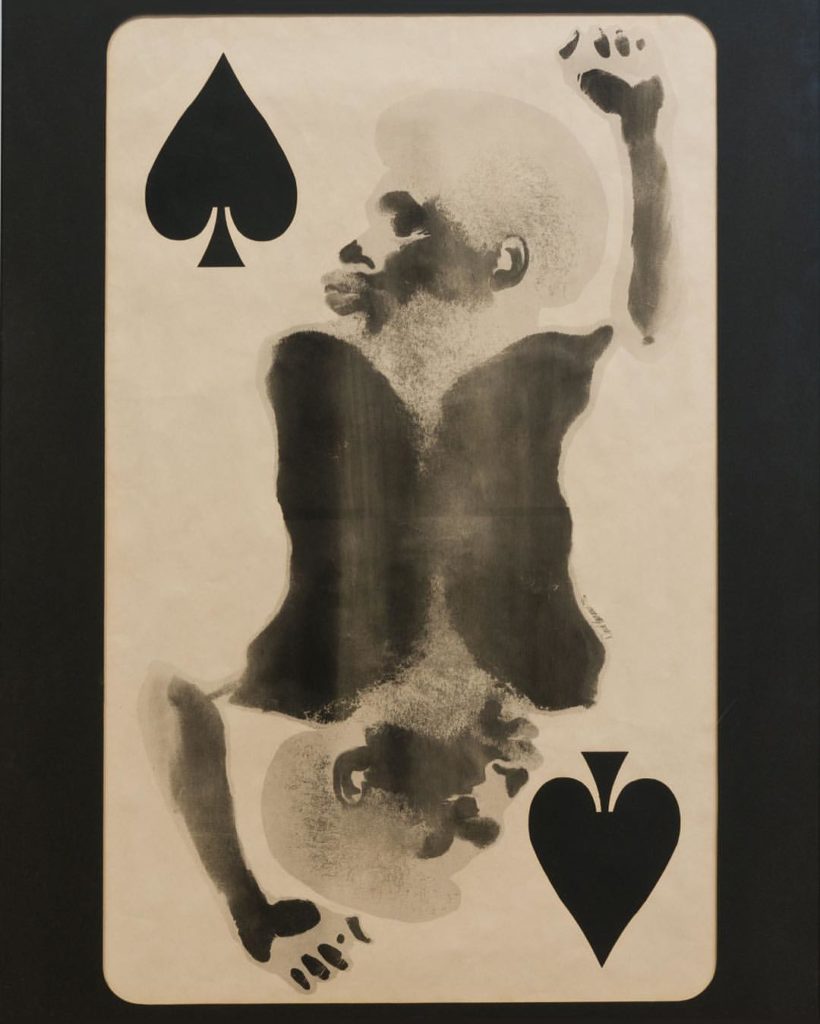
David Hammons, Spade (Power for the Spade), 1969. Courtesy of David Hammons/the Tilton Family Collection.
If you could steal one work of art without getting caught, what would it be?
It would probably be either a David Hammons or an El Anatsui. If you see an El Anatsui in my home… either I stole it or I won the lotto and didn’t tell anybody. I’d make a little shrine to it. You couldn’t even walk into that room.
What does style mean to you? How do you define the relationship between your art and style?
My style ethos is not that different from how I approach collecting art. I balance a lot of classic, elegant designers with some fresh new voices. I love wearing color in a sea of black, which is a lot of what you see at art functions. It brings me tremendous joy.
What does art mean to you?
I am a very visual person. I’m a radiologist, so I look at images all day long. Art in my home is my shelter, it’s my special place. I didn’t grow up with art as a child. My parents were modest, middle-class people.
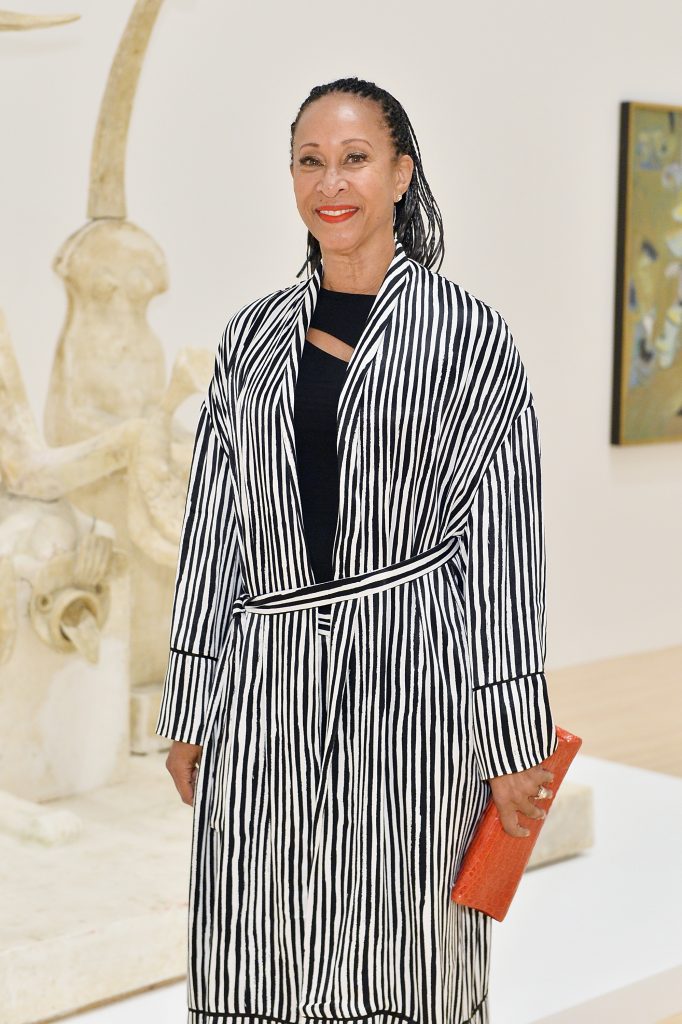
Joy Simmons attends Chloe x MOCA Dinner at MOCA Grand Avenue on September 19, 2017 in Los Angeles, California. (Photo by Stefanie Keenan/Getty Images for Chloe)
I always wanted my space to reflect me. Even when I started out with Jimi Hendrix posters as an undergraduate, and then I started buying art posters, you knew when you walked into that space that it was Joy’s space. And I think I have continued that in my collecting philosophy. I don’t want to have the same things that everyone else has because that doesn’t speak to me as a collector or as a person.
Collecting art, having it reflect our time, and meeting the artists is important to me. That’s what I hope to share with my daughters and my grandchildren, who are growing up and seeing these images of Black people and Black artists. If it’s abstract, what does that say and what does that do? I like talking to them about these kinds of things, and just having them connect when they walk in and they see a Lauren Halsey-wrapped column that says something to them that’s vibrant and fun and still impactful.
